What Is So Modern About the Art of Neoclassicism?
The Neoclassical menstruum, Neoclassicism or Neo-Classicism, was a revival of Greek and Roman art and architecture in Europe. It occurred around the middle of the 1700s (18thursday Century) and continued during the 1800s (19th Century). Neoclassicism was not simply a upshot of new discoveries from Greek and Roman art and architecture, merely it was likewise a revolt against the opulence of the Baroque and Rococo art movements that came earlier.
Table of Contents
- 1 An Introduction to Neoclassicism
- 1.ane The Renaissance vs. the Historic period of Enlightenment
- ane.2 The Influences and Evolution of Neoclassicism
- 1.3 The Key Characteristics of Neoclassical Art
- 2 Famous Neoclassical Artists
- 2.i Neoclassical Painting
- 2.two Neoclassical Sculpture
- 2.three Neoclassical Architecture
- 3 The Ever Continued Neoclassical
- 4 Ofttimes Asked Questions
- four.1 What Is Neoclassicism?
- 4.ii When Was the Neoclassical Period?
- 4.three What are the Chief Characteristics of Neoclassicism?
- iv.4 What Influenced the Neoclassical Movement?
An Introduction to Neoclassicism
First, permit us look at the term "Neoclassical", the prefix neo originates from Greek roots (northward é os), co-ordinate to the Merriam-Webster Dictionary online information technology translates to "young, fresh, new". The word "classics" also translates from the Latin word classicus, which denotes the highest rank, or highest grade.
The term Classical refers to the Classical era when Greek and Roman ideals thrived and informed a manner of life and culture. It was in fact a new movement in the arts, spanning not only painting, but architecture, sculpture, and even the decorative arts and interiors like furniture. But, what fabricated Neoclassicism new? Let united states of america explore it further.
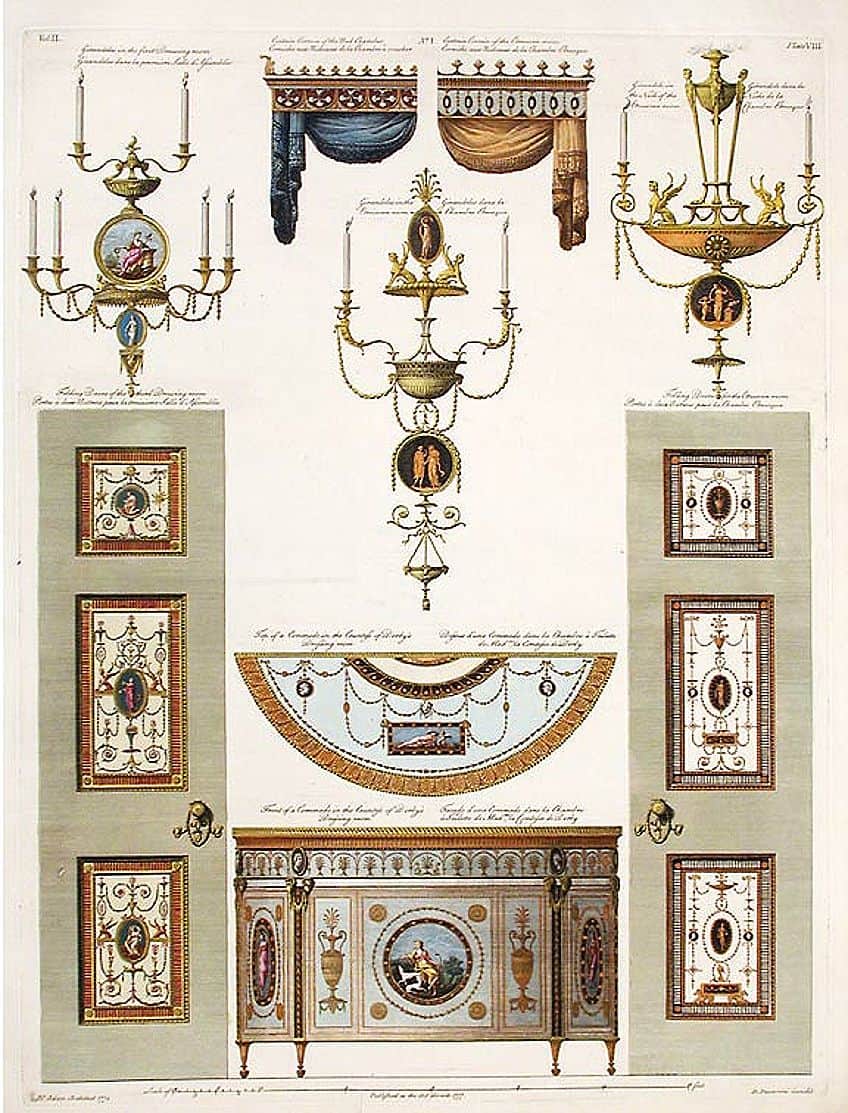 Details for Derby House in Grosvenor Square(1777) by Robert and James Adam; Run into folio for author, Public domain, via Wikimedia Commons
Details for Derby House in Grosvenor Square(1777) by Robert and James Adam; Run into folio for author, Public domain, via Wikimedia Commons
The Renaissance vs. the Age of Enlightenment
Neoclassicism art was a revival of Classical ideals, and information technology is of import to identify it contextually to understand it as a movement. Neoclassicism was influenced past significant changes taking place in Europe, specifically two massive shifts within order after the Medieval Ages.
We have the Renaissance, which lasted from the 1300s to the 1600s. During this time in Europe, at that place were changes and advances in near every aspect of man understanding and the humanities, for example, technology, scientific discipline, mathematics, politics, and culture. And then nosotros accept the Age of Enlightenment (or Historic period of Reason), which started during the 1600s (17thursday Century) and lasted until the early 1800s (19th Century).
Artists during the Renaissance period sought to emulate the Classical ideals from the Greek and Roman periods. Art was naturalistic and true to reality, along with the philosophical ethics of Humanism, which placed the individual at the eye of his artistic power. The term Renaissance means "rebirth" and information technology was undoubtedly a rebirth of new ways of seeing and exploring life.
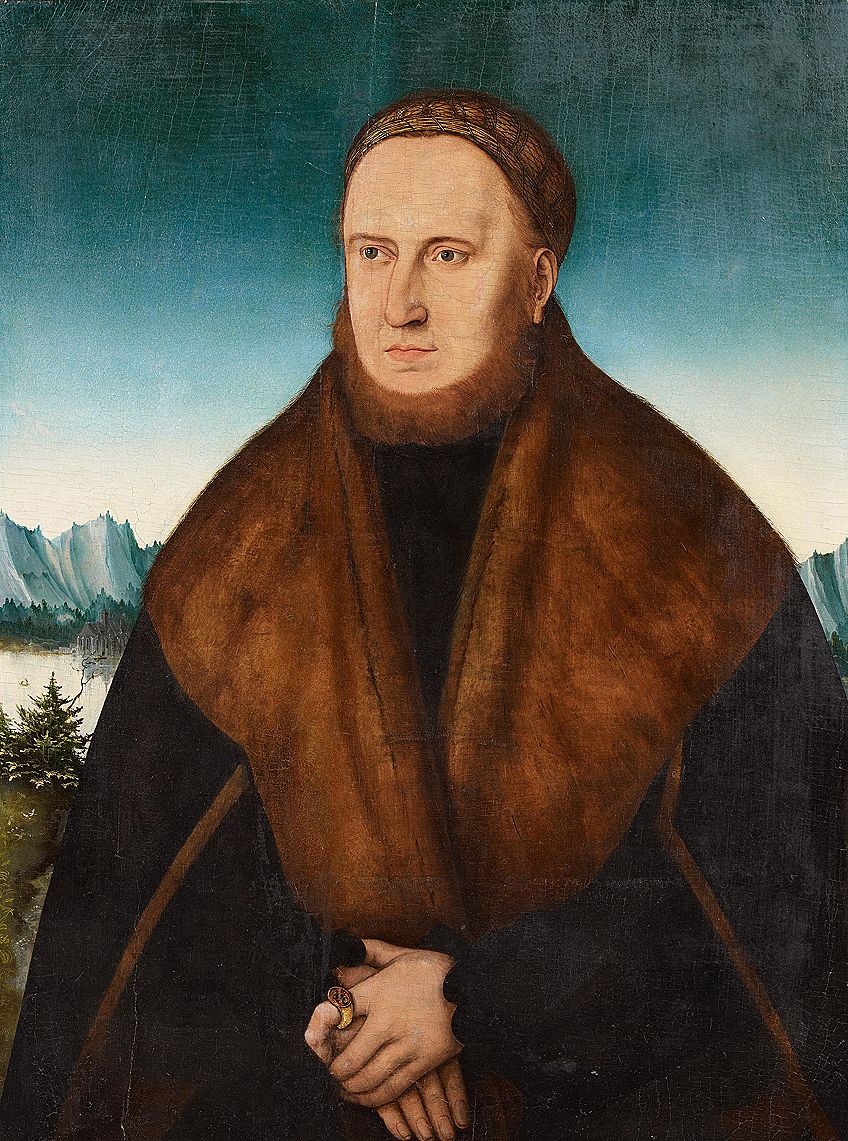 Portrait of a Disguised man with a Cap and a Fur-Tanned Coat(1530) by a fellow member of the Danube Schoolhouse; Circle of Lucas Cranach the Elder, Public domain, via Wikimedia Commons
Portrait of a Disguised man with a Cap and a Fur-Tanned Coat(1530) by a fellow member of the Danube Schoolhouse; Circle of Lucas Cranach the Elder, Public domain, via Wikimedia Commons
The Historic period of Enlightenment, also Age of Reason, was founded in philosophical thought. Reason became the identifying gene for many ethics like progress, liberty, fraternity, and tolerance, to name a few. Reason and philosophical thought were regarded as a ways of higher understanding of man'southward place in the world.
The Age of Enlightenment was influenced by the Scientific Revolution, which developed during the last remnants of the Renaissance period. Information technology informed many of the scientific discipline-based faculties like mathematics, biology, physics, astronomy, chemistry, including human anatomy. Information technology replaced many ideas regarded as scientific, for example, star divination. It also utilized the new scientific method, which approached enquiry with more scientific experimentation based on quantitative facts and ascertainment.
This was besides what led to Empiricism, which believed knowledge just derives from the external globe of the senses and experience.
Philosophers and scientists from the Enlightenment period were influenced past many of the ideas from the Scientific Revolution and they also had an educational background in science. This period in history saw the dominance of science over organized religion and how new fact-based concepts replaced the organized religion-based way of viewing life and nature.
The forerunners of the Enlightenment and their seminal publications were cornerstones to the evolution of rational idea and prepare the foundations for the developments of this era. These included, amongst others, Isaac Newton's (1642-1727) Principia Mathematica (1686) and John Locke's (1632-1704) Essay Concerning Man Understanding(1689).
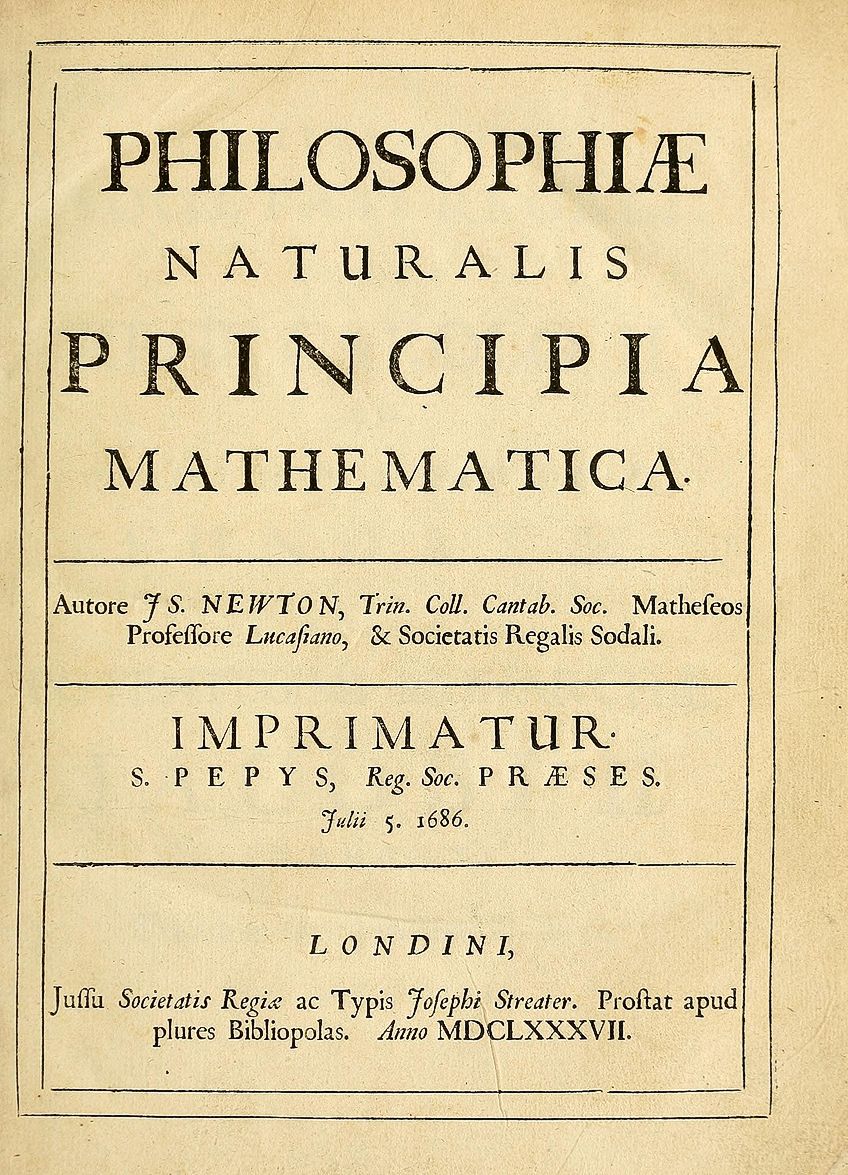 Title Folio of Principia(1687) by Isaac Newton;The original uploader was Zhaladshar at English Wikisource. , Public domain, via Wikimedia Commons
Title Folio of Principia(1687) by Isaac Newton;The original uploader was Zhaladshar at English Wikisource. , Public domain, via Wikimedia Commons
The Influences and Development of Neoclassicism
Although the Enlightenment was a major proponent of the development of Neoclassicism, other major proponents included the work of Johann Joachim Winckelmann (1717-1768) who wrote his seminal works on Classical art and compages and the rise of exploration in Europe, specifically the Grand Bout.
With the rise in popularity of the new fields of Archaeology and the earthworks of ancient sites like Herculaneum (excavated in 1738) and Pompeii (excavated in 1748), there was an increased curiosity to discover artifact. The 1000 Bout made a new mode of discovering antiquity possible throughout Europe.
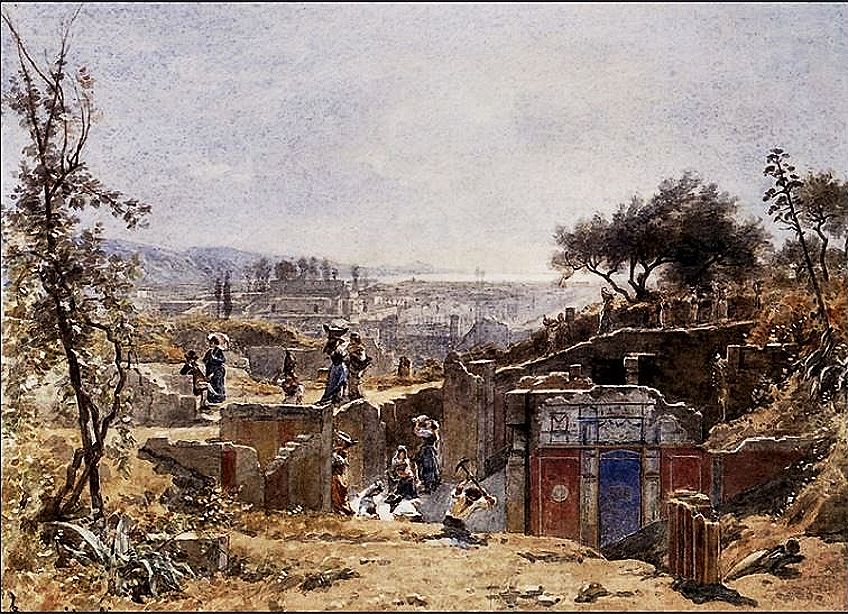 Excavations at Pompeii(1886) by François-Louis Français;François-Louis Français, Public domain, via Wikimedia Commons
Excavations at Pompeii(1886) by François-Louis Français;François-Louis Français, Public domain, via Wikimedia Commons
It was done equally a rite of passage for young, coming of age, upper-class men, as well equally artists and scholars seeking higher education. Information technology involved an extended period of travel around the creative and cultural hubs in Europe, which included Greece and Rome.
Although the Chiliad Tour was just for the upper course, men brought dorsum many souvenirs from their travels, and their extensive collections disseminated the fine art and civilisation from the Classical era informing the Neoclassical motion.
It was also German, Winckelmann, that laid the foundation for art historical texts virtually Greek and Roman artworks, but also creating the start chronological ordering of Greek fine art and architecture inside a scholarly text. Winckelmann was famously known equally the "male parent" of art history as he wrote two important publications that would become pregnant contributions in art history.
These 2 publications were, "Thoughts on the Imitations of Greek Works in Painting and Sculpture" (Gedanken über die Nachahmung der griechischen Werke in der Malerei und Bildhauerkunst (1750) and "The History of Art in Antiquity" (Geschichte der Kunst des Alterthums) (1764).
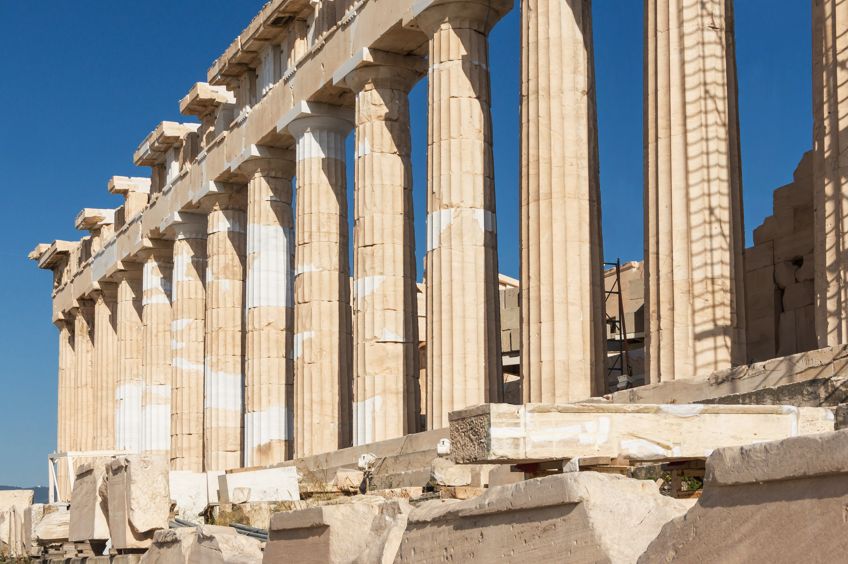 A photograph of the Colonnade Parthenon Acropolis in Athens, Greece (2015);Jebulon, CC0, via Wikimedia Commons
A photograph of the Colonnade Parthenon Acropolis in Athens, Greece (2015);Jebulon, CC0, via Wikimedia Commons
The first publication had a profound issue on the theoretical frameworks of Neoclassicism every bit information technology explored the importance of imitating Greek Art. He is oftentimes quoted from his text, "the one way for us to become great, perchance inimitable, is by imitating the ancients". Notwithstanding, it is important to note in that location has been considerable debate among fine art scholars as to the context in which Winckelmann places his term "imitation".
It is also of import to distinguish between the ideas of "imitating" and "copying" art, which are concepts Winckelmann expounded on in his reflections. He explored the Classical ideals extensively in his texts, although some scholarly sources also indicate that it is important to place his observations within conscientious context, namely that he never traveled to Greece himself, and he merely came into contact with these artworks through Rome. Nonetheless, his contributions impacted the world of art history for centuries to come.
The Key Characteristics of Neoclassical Fine art
There are many identifiable characteristics of Neoclassicism art, but 1 of the master ideas of this fine art movement was the movement abroad from the overly decorative mode of the Baroque and Rococo art movements. We will discover the Neoclassical way in painting, architecture, and sculpture. Nonetheless, this style was non but within the arts, merely it was also dominant in music, theatre, and literature. Beneath we look at some of the mutual characteristics that define and shape Neoclassical Art.
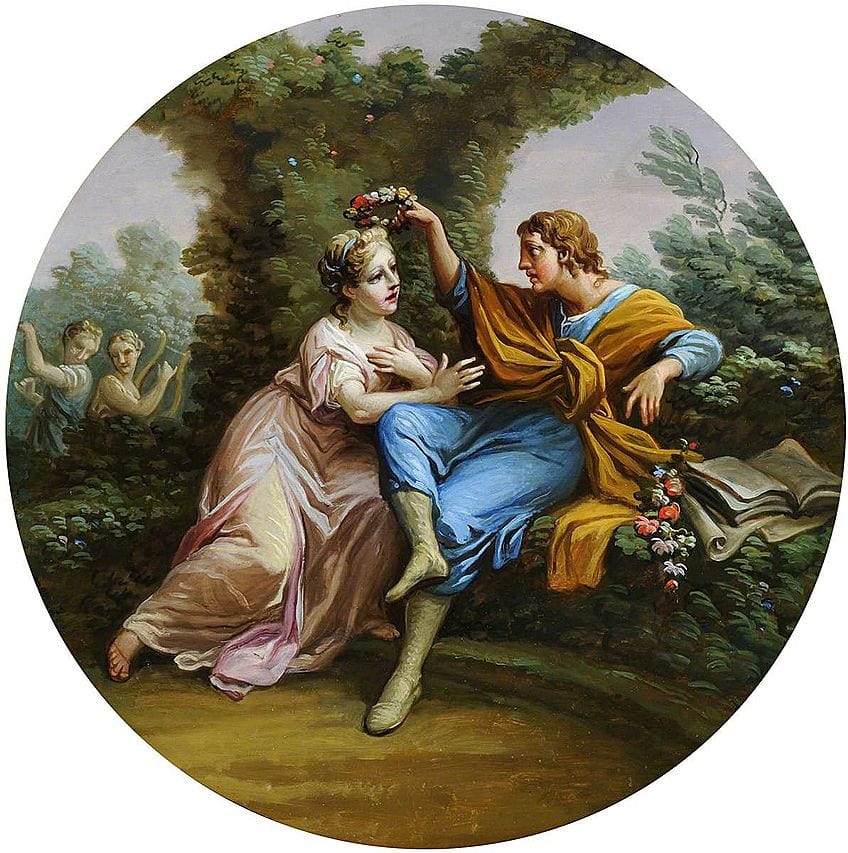 Daphnis Bestowing a Garland of Flowers on Chloe(1776) by Antonio Zucchi;Antonio Zucchi, Public domain, via Wikimedia Eatables
Daphnis Bestowing a Garland of Flowers on Chloe(1776) by Antonio Zucchi;Antonio Zucchi, Public domain, via Wikimedia Eatables
Noble Simplicity
"Noble simplicity" is often cited from the forefather of the Neoclassical ideals, Johan Joachim Winckelmann in his publication "Thoughts on the Imitations of Greek Works in Painting and Sculpture" (1750), as he writes most Greek sculptures and their inherent "quiet grandeur". He exemplifies this further with reference to the art of Raphael, who was one of the best-known painters during the High Renaissance.
One of the main characteristics of Neoclassical art was its render to ideals of "simplicity", "symmetry", "proportion", and "harmony". This simplicity of course and shape was seen in Neoclassical painting, architecture, and sculpture.
It was a revival of the simplicity of class and shape from the Greek and Roman periods. This simplicity was too expressed through subdued and often tempered colors, which were meant to indicate a formality and a somewhat superiority. This element of superiority was seen in the age of Antiquity and many ethics related to morals and ethics.
Didactic Discipline Affair
It was the potent conventionalities in virtues and morals that underpinned the narratives and effects of storytelling through Neoclassical painting. The blazon of field of study thing utilized was of mythological scenes and characters, as well as historical scenes taken from Greek and Roman sources. It was besides believed that Neoclassical Fine art was meant to assist whoever viewed information technology by telling a story that inspired and gave a message based on morals and ethical values.
There was frequently an chemical element of heroism in the narrative, every bit well as a singled-out seriousness and austerity. In other words, Neoclassical art was didactic, which means its message was meant to convey a lesson.
Famous Neoclassical Artists
Although there were many corking artists of the Neoclassical period, below we look at some of the more popular Neoclassical artists and their artworks within the fields of painting, sculpting, and architecture. In that location are two important artists worth noting when it comes to influences on Neoclassical Art and they are, namely, Nicolas Poussin (1594-1665) and Claude Lorrain (c.1604-1682).
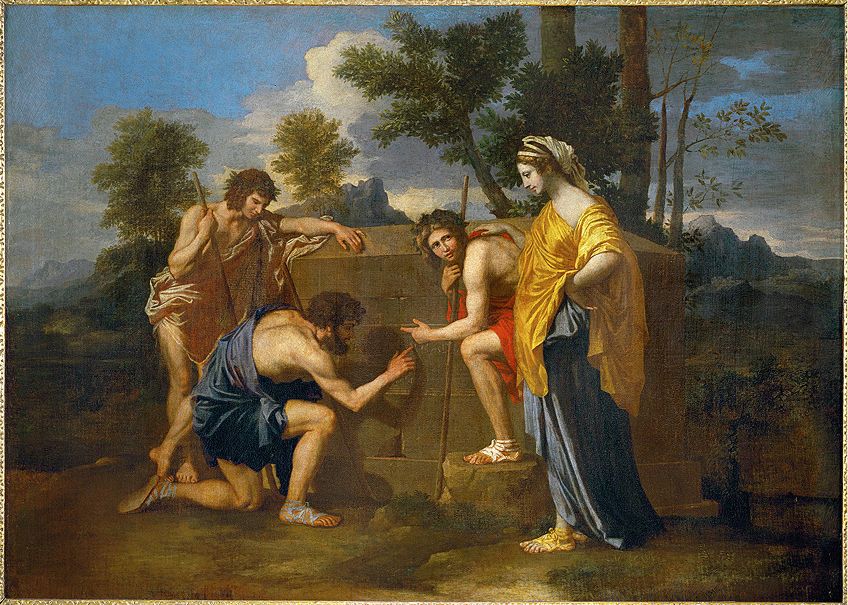 Et in Arcadia ego(1638-40) by Nicolas Poussin; Nicolas Poussin, CC BY-SA 3.0, via Wikimedia Commons
Et in Arcadia ego(1638-40) by Nicolas Poussin; Nicolas Poussin, CC BY-SA 3.0, via Wikimedia Commons
The to a higher place-mentioned artists were French, from the Baroque period. Still, their mode depicted the classical ideals of the orderliness of composition and historical scenes often from the Bible, mythology, or history. Nicolas Poussin was highly regarded for his paintings of the above-mentioned subject area matter, including his more rational arroyo to painting versus expressiveness and ostentatiousness seen in Baroque Art.
Poussin'due south art was too influenced by Hellenistic principles and he painted in a mode where those who viewed information technology would receive a deeper meaning from the narrative portrayed. He influenced notable Neoclassical painters like Jacques-Louis David.
Neoclassical Painting
Neoclassical painting can exist divided into 2 distinct developmental stages, namely, Early on and Late Neoclassicism. Information technology evolved as the opposite in manner and composition to that of its precedent, the Rococo, where paintings appeared lighter and more improvident in style.
Neoclassical painting is characterized by a cleaner manner of brushwork and application, nosotros will see a smoother surface with brushstrokes creating solidity instead of airiness, furthermore, forms are depicted with more solidity and definition. Color is as well true to nature and subject matter is portrayed truthful to history or mythology.
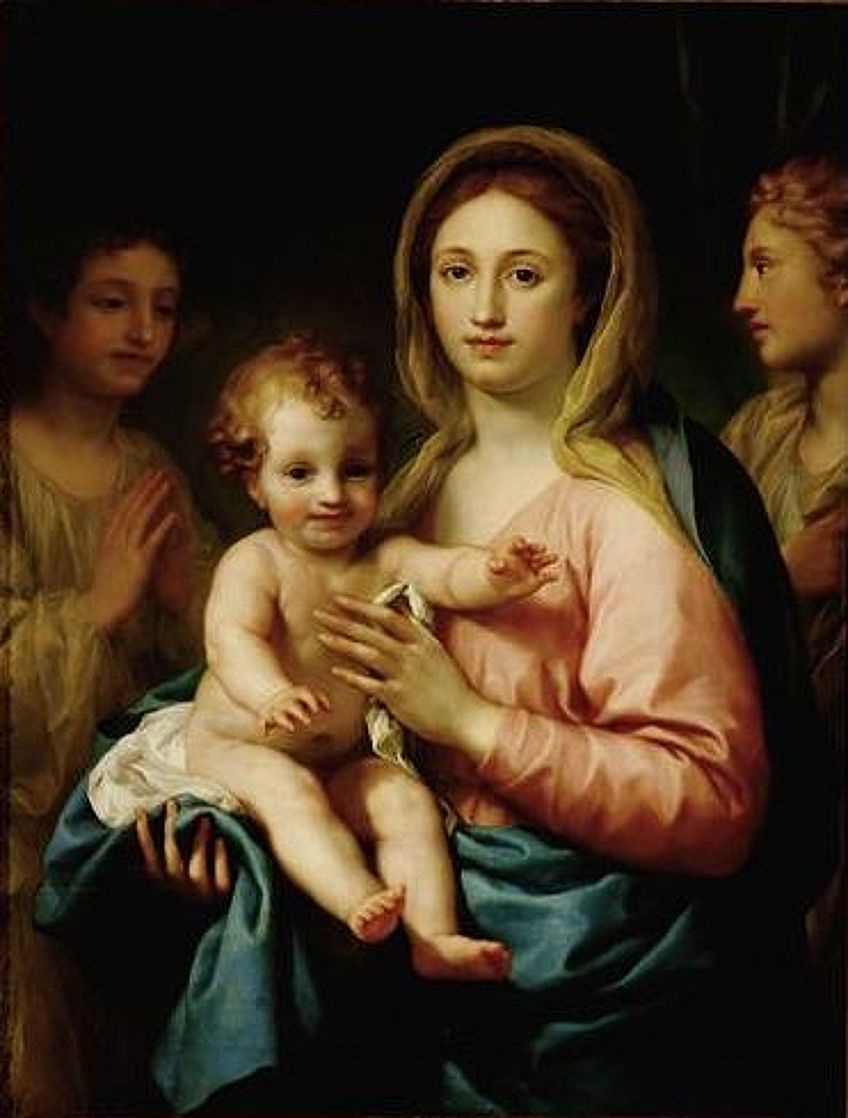 Maria mit dem Kind und zwei Engeln('Maria with the child and two angels,' 1773) by Anton Raphael Mengs;Anton Raphael Mengs , Public domain, via Wikimedia Commons
Maria mit dem Kind und zwei Engeln('Maria with the child and two angels,' 1773) by Anton Raphael Mengs;Anton Raphael Mengs , Public domain, via Wikimedia Commons
The Neoclassical painting mode developed in Rome with Anton Raphael Mengs (1728-1779) setting the foundations along with Johann Joachim Winckelmann. The style evolved in U.k. with other notable artists similar the Swiss Angelica Kauffman (1741-1807) and Benjamin West (1738-1820). During the Later Neoclassical period, artists like Jacques-Louis David (1748-1825) led the style in France and became the image of the Neoclassical mode.
The distinguishing factor for Neoclassical painting is that artists painted their subject area matter from the examples they found from Ancient Greek and Roman compages and sculpture, as well as from examples of paintings earlier them, like Baroque and Rococo. Below we look at some of the artworks from the prominent Neoclassical painters of their time.
Anton Raphael Mengs (1728 – 1779)
Mengs was a Bohemian painter and considered i of the forerunners of Neoclassical painting, although he yet painted within the Bizarre fashion at the time. He believed in the significance and place of the Classical, this was also a shared value and conventionalities with the Winckelmann, with who he worked closely. Co-ordinate to various scholarly sources, Mengs was described by Winckelmann as the "greatest" artist of his time.
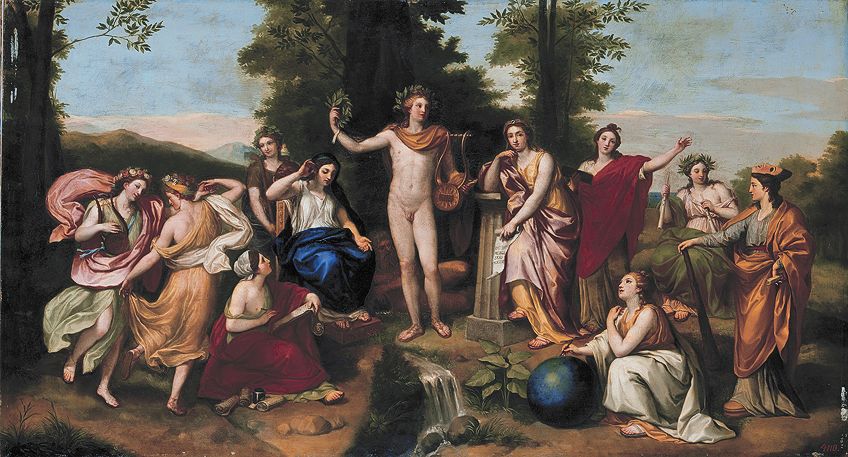 Parnassus(1761) by Anton Raphael Mengs;Anton Raphael Mengs , Public domain, via Wikimedia Commons
Parnassus(1761) by Anton Raphael Mengs;Anton Raphael Mengs , Public domain, via Wikimedia Commons
One of his well-known artworks Parnassus (1761) depicts his move towards the Neoclassical menstruum. Information technology was created as an oil sketch equally office of the fresco for the Villa Albani located in Rome. Mengs was inspired by Raphael'southward fresco similarly titled The Parnassus (c.1509-1511). It depicts a mythological story most Apollo (the Dominicus God), which is in the center of the composition surrounded past diverse muses. In this painting past Mengs, we notice the more subdued coloring on the robes and cleaner lines of the grade.
Benjamin West (1738 – 1820)
Benjamin Due west was an American-built-in painter, nonetheless, through his extensive travels to Rome and then England he became one of the popular British painters, with subject affair centered on historical narratives. West likewise intended for his paintings to accept a deeper moral meaning. He was deeply influenced past the Classical ideals from the Greek and Roman fine art he experienced during his travels to Rome, which he undertook during the 1760s, as well the ethics and virtues from the Enlightenment.
West also studied under prominent scholars Winckelmann and collaborated with other pop artists of the time, namely Angelica Kaufmann and Gavin Hamilton (1723-1798). West has an extensive historical background, especially his time spent in England. He was a fellow member of the Majestic University of Arts in 1768, of which he became the president, and painted for Male monarch George Three.
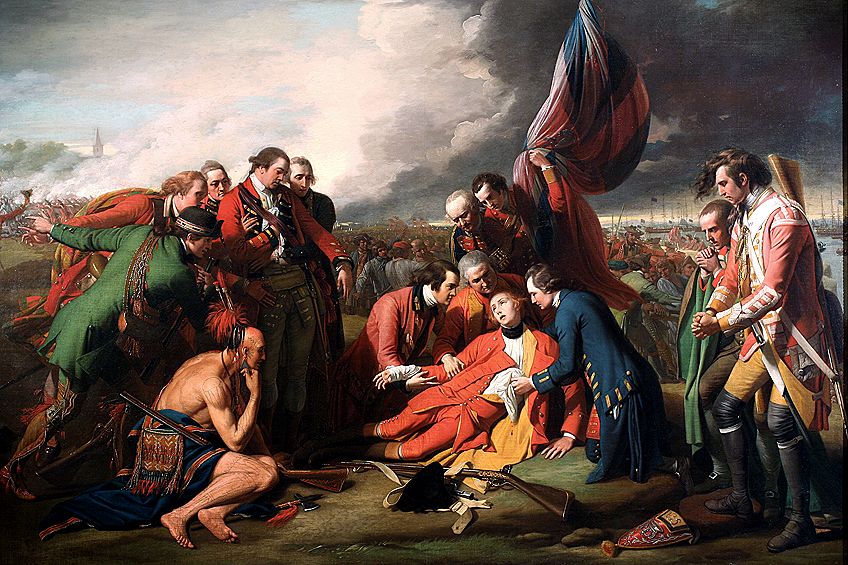 The Decease of Full general Wolfe(1770) by Benjamin Westward;Benjamin W, Public domain, via Wikimedia Commons
The Decease of Full general Wolfe(1770) by Benjamin Westward;Benjamin W, Public domain, via Wikimedia Commons
Some of West's notable artworks include The Decease of General Wolfe (1770), which was one of his most famous artworks depicting the Battle of Quebec. What made this artwork so revolutionary was how West depicted the characters in their modern-day uniforms, and non in classical dress, even so, this is reported to have been done already by another artist, Edward Penny (1714-1791).
Angelica Kauffman (1741 – 1807)
Angelica Kaufmann was a Swiss-born artist and displayed artistic talent from a young age. She became a famous artist during her time in London, where she moved to after a period of traveling to Europe with her father. She managed to support herself successfully as a female artist and was well respected every bit such by her customs.
Kaufmann had a broad telescopic equally a painter, including portraits, landscape, and decorative painting. She was known equally having a manner related to Rococo Art, but she also adopted the Neoclassical fashion of history painting during the 1770s. She drew inspiration from Classical texts past writers like Homer and Alexander Pope. She likewise worked alongside Benjamin West, as another fellow member of the Royal Academy, and both artists popularized British historical paintings.
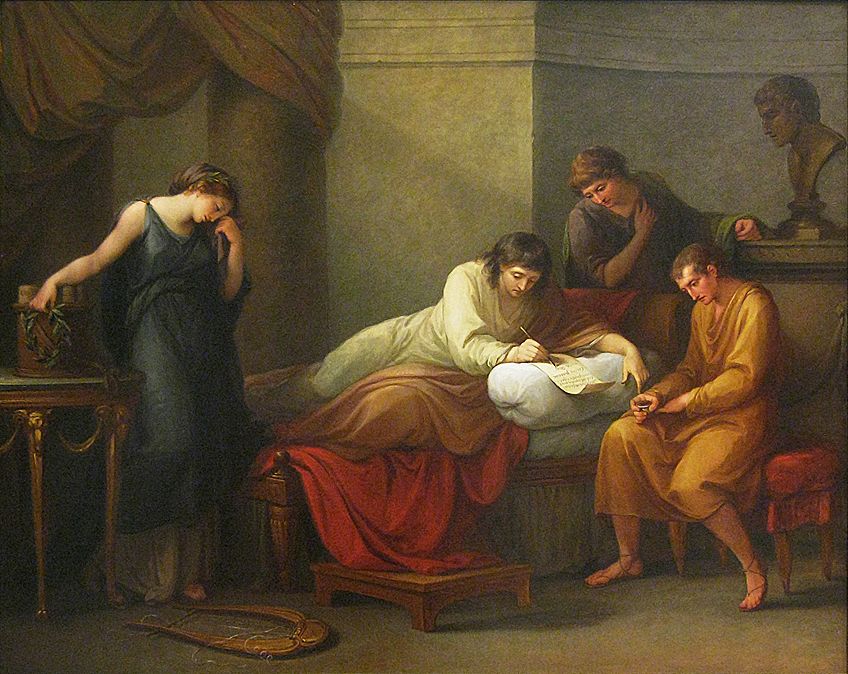 Virgil Writing his Epitaph at Brundisi(1785) by Angelica Kauffman;Carnegie Museum of Fine art, Public domain, via Wikimedia Eatables
Virgil Writing his Epitaph at Brundisi(1785) by Angelica Kauffman;Carnegie Museum of Fine art, Public domain, via Wikimedia Eatables
Some of her more than famous artworks include Cornelia, Mother of the Gracchi, Pointing to Her Children as her Treasures(1785), wherein we discover the differences in how discipline matter is portrayed compared to the more light-hearted Rococo manner. Evident in this painting is a more serious tone, and figures are depicted in more than subdued colors. The subject thing is also of Roman history of the politicians Tiberius and Gaius Gracchus.
Jacques-Louis David (1748 – 1825)
Jacques-Louis David is probably considered the epitome of Neoclassical painters and his artworks truly depict the essence of Neoclassical ethics and style. Born in Paris, David would continue his art career in Rome, where he besides produced many of his about famous paintings, for example, The Adjuration of the Horatii (1784).
It is of import to note that David produced his artworks during the aforementioned time of the French Revolution, and he was also a part of the French Revolution, specifically function of the Jacobin political club during 1789. His famous piece, The Oath of the Horatii (1784), was besides associated with the French Revolution and what information technology stood for, but information technology is known that this piece was produced for a patron before the events of the Revolution.
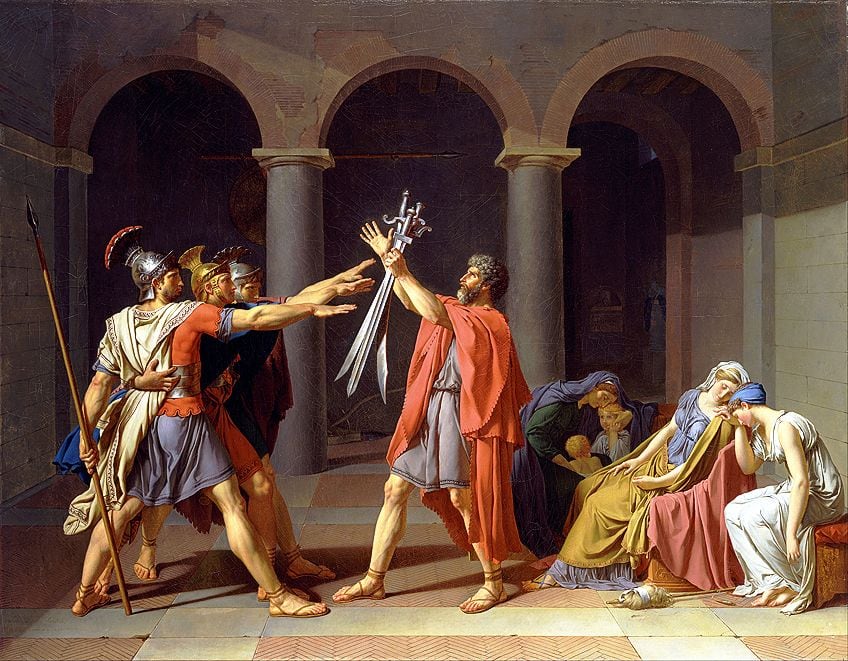 Oath of the Horatii(1786) by Jacques-Louis David;Anne-Louis Girodet de Roussy-Trioson, Public domain, via Wikimedia Commons
Oath of the Horatii(1786) by Jacques-Louis David;Anne-Louis Girodet de Roussy-Trioson, Public domain, via Wikimedia Commons
When we look at this famous piece past David, we conspicuously discover the clean lines, symmetry, and heroic virtues so feature of the Neoclassical movement. It depicts the Roman story of the Horatii trio of brothers swearing to protect their country, Rome, against the Albans, of which likewise 3 brothers, the Curatii, would exist their counterparts in boxing.
The composition clearly portrays the subject matter, we meet the three brothers to the left and women mourning behind them (one of them in a relationship with one of the Curatii brothers, which emphasizes their distraught emotions).
The central figure is Horatius, belongings upwards iii swords for the three brothers. Behind the figures, we detect three singled-out arches, each one coinciding with the figures in the foreground.
The arches place more emphasis on the figures and what is taking place in the foreground, this, again, is highlighted past the stark lighting making the whole scene clear. We find David keeps the composition uncomplicated and does not distract past adding any other elements or decorations to the painting. The three arches in the groundwork create a seeming backdrop, which "sets the stage", so to say, for the primal figures in the foreground.
Other important artworks past David include the Death of Marat (1793), which depicts the dead body of Jean-Paul Marat, who was murdered past Charlotte Corday. Marat was a French politician and journalist, among other merits. This painting was done during the height of the French Revolution and what was known every bit the Reign of Terror, which consisted of public executions and numerous massacres.
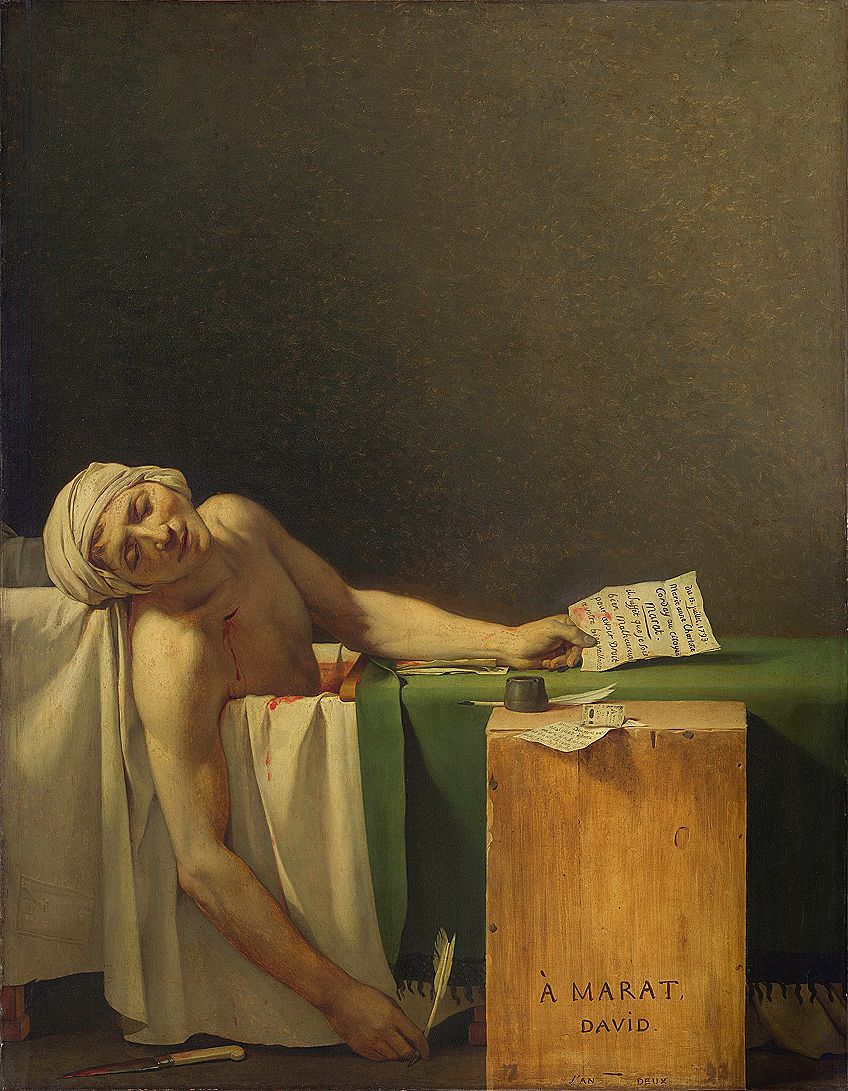 The Decease of Marat(1793) by Jacques-Louis David; Jacques-Louis David, Public domain, via Wikimedia Commons
The Decease of Marat(1793) by Jacques-Louis David; Jacques-Louis David, Public domain, via Wikimedia Commons
This painting was done in retention of Marat and we volition discover how David idealized the dead figure using Biblical references of Christ'due south dead body. This is axiomatic in the Marat's hanging arm, symbolizing Christ'southward arm with reference to the Michelangelo's marble sculpture titled, Pietà, the turban around his caput, which is a symbol for a halo, and the seeming gracefulness of his dead trunk – there is a sense of martyrdom depicted.
What makes the painting more than existent is the letter in Marat'south hand, which is clearly readable. Information technology is from Charlotte Corday herself, it is written in French and translated to English, it reads: "July 13, 1793. Marie Anne Charlotte Corday to the citizen Marat – Given that I am unhappy, I accept a right to your aid".
Jean-Auguste-Dominique Ingres (1780 – 1867)
Ingres was some other prominent French Neoclassical painter who studied under the tutelage of Jacques-Louis David. He was a strong proponent of Poussin's manner of art, which was towards more rational and clear approaches to depicting elements similar form and line. Nevertheless, we will notice at that place is more than expressiveness of grade in his paintings, which is reminiscent of the attributes associated with Romanticism.
An case of one of his artworks is the La Grande Odalisque (1814), which depicts a nude woman staring at the onlooker. This artwork has continued into the Modern era in terms of the place of female nudes and the human relationship with the male person every bit the onlooker.
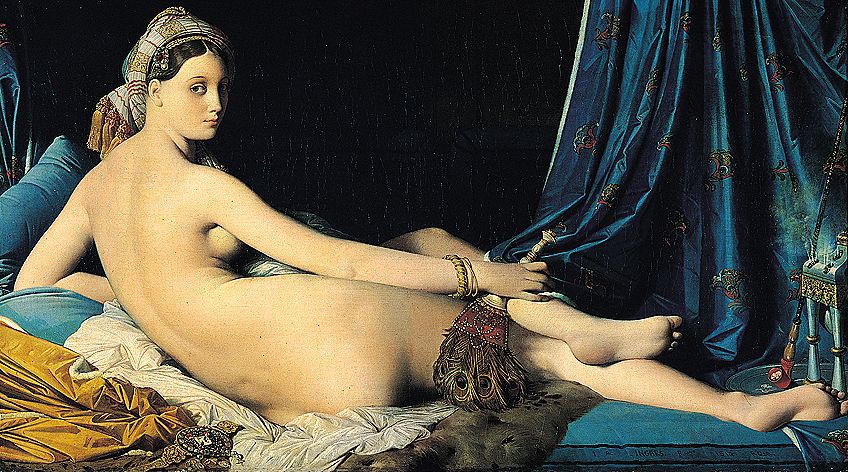 La Grande Odalisque(1814) by Jean Auguste Dominique Ingres;Jean-Auguste-Dominique Ingres, Public domain, via Wikimedia Commons
La Grande Odalisque(1814) by Jean Auguste Dominique Ingres;Jean-Auguste-Dominique Ingres, Public domain, via Wikimedia Commons
We also notice how Ingres is still utilizing the subject matter equally a female nude, characteristic of the Classical era, he as well utilizes the, often termed, "make clean lines", characteristic of Neoclassical art, but he moves across the rigidity of Neoclassicism in the manner he depicts the nude – there is more expressiveness and a plow abroad from the overt realism of human form as we find her proportions are non exactly true to nature.
Neoclassical Sculpture
Neoclassical sculptures drew considerable inspiration from the archaeological digs in Rome and Greece at the fourth dimension, peculiarly that of Pompeii. Sculptors were also provided with a wide variety of models to work from, this was quite the opposite for Neoclassical paintings, which had a lesser number of existent-life examples to work from to emulate the Classical ideals.
Some common characteristics of Neoclassical sculpture include its size, sculptures would often be made life-sized and focused on symmetrical correctness. Subject matter often had a more serious tone merely would range from mythological, to historical, even to existent-life personalities like actors, singers, and famous philosophers as is evident in the piece of work of Jean-Antoine Houdon (1741-1828), who produced his famous portrait busts.
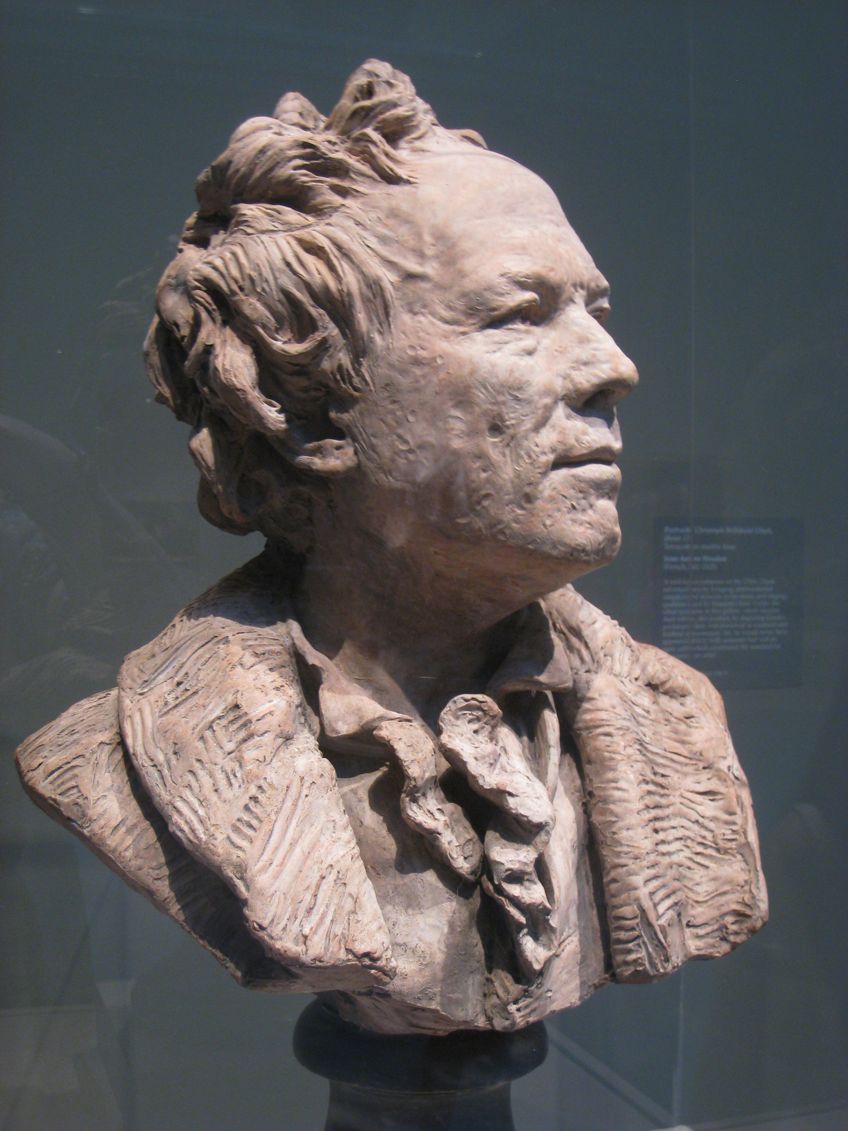 Bust of Christoph Willibard Gluck(1775) by Jean-Antoine Houdon; Jean-Antoine Houdon, Public domain, via Wikimedia Commons
Bust of Christoph Willibard Gluck(1775) by Jean-Antoine Houdon; Jean-Antoine Houdon, Public domain, via Wikimedia Commons
Another common trait among Neoclassical sculptors was a combination of depicting field of study affair in idealistic forms or with naturalism and realism referred to as verism, which was also referred to equally "warts and all". This manner of depiction was used in Roman sculpture and believed in including all the traits seen on a body, whether information technology be warts, wrinkles, or anything else that would be considered "imperfections" – this gave a heightened sense of realism.
Some of the top Neoclassical sculptors included Jean-Antoine Houdon (mentioned in a higher place), who was in France as a leading sculptor during the French Enlightenment period, Antonio Canova (1757-1822), and Bertel Thorvaldsen (1770-1844), who were pioneering sculptors working in Rome.
Each sculptor had a dissimilar arroyo. However, they are also noted to have depicted a sense of idealism in their sculptures.
Thorvaldsen and Canova sculpted mythological subject matter, examples of their sculptures include Canova'due south Psyche Revived by Cupid'southward Kiss (1787-1793), housed in the Louvre in Paris. It depicts Cupid and Psyche in the throes of kissing after she was woken upwardly by Psyche himself with a kiss. Canova was born Italian and primarily worked in Rome. He was well-known to have produced work that was more "warm" and lite in its portrayal.
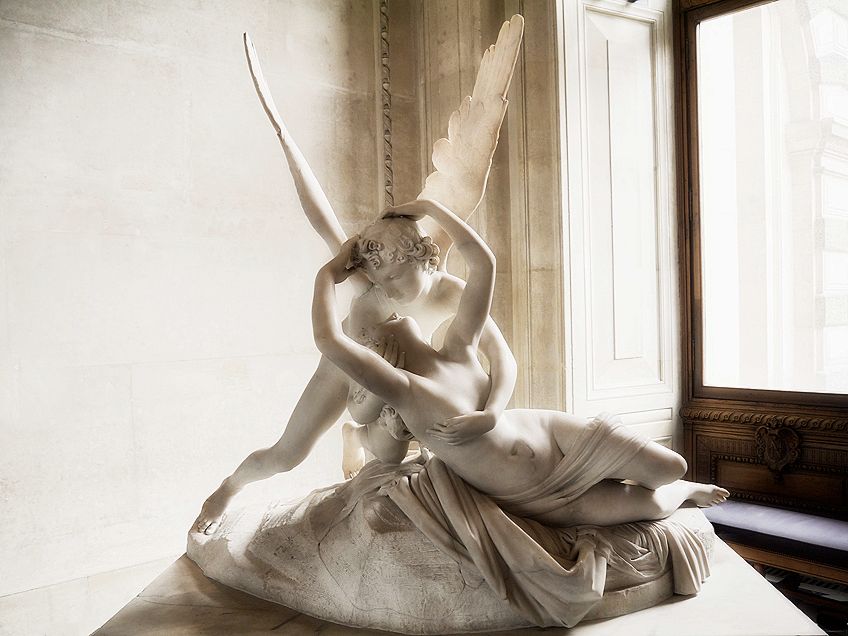 Psyche Revived by Cupid'southward Osculation(1787) past Antonio Canova; Kurtab123, CC Past-SA 4.0, via Wikimedia Commons
Psyche Revived by Cupid'southward Osculation(1787) past Antonio Canova; Kurtab123, CC Past-SA 4.0, via Wikimedia Commons
Thorvaldsen worked in Rome during his adult years and focused on works that were heroic in nature. He was original of Danish descent, born in Copenhagen. An instance of his work includes Jason with the Golden Fleece(1802-1803) and Monument to Copernicus (1822-1830).
Many sources indicate that Thorvaldsen'due south work has been described as more than "astringent" in its style. He depicted his subject affair with a sense of dignity and heroism. Nosotros are able to discover this sense of severity in his well-known work Jason and the Gilt Fleece (1802-1803), having depicted the mythological character of Jason with a sense of heroic prowess, even though the actual graphic symbol of Jason in mythology was not hailed exactly as a hero.
Neoclassical Compages
Neoclassical compages became a testament to the ideals and virtues in Neoclassicism. There have been endless buildings of all types constructed inside the Neoclassical way. Neoclassical architecture besides conveys seriousness and orderliness in its construction and facades, and so to say, having imitated Greek and Roman architecture. Information technology started flourishing during the middle of the eighteenth Century and plant all over Europe in countries like Federal republic of germany, French republic, Russian federation, and Britain.
The Neoclassical architectural manner was likewise influenced by two important architects, namely, the Roman Vitruvius, from the anest Century BC, and the Renaissance builder Andrea Palladio (1508-1580). Palladio was known for simplifying the already existing architectural structures and elements existent from the Renaissance.
He was influenced by Greek and Roman architecture; however, information technology is also noted that he did not exactly imitate these structures, merely included his ain elements to innovate new designs. He was likewise similarly influenced by Vitruvius and how he utilized elements similar symmetry and proportion.
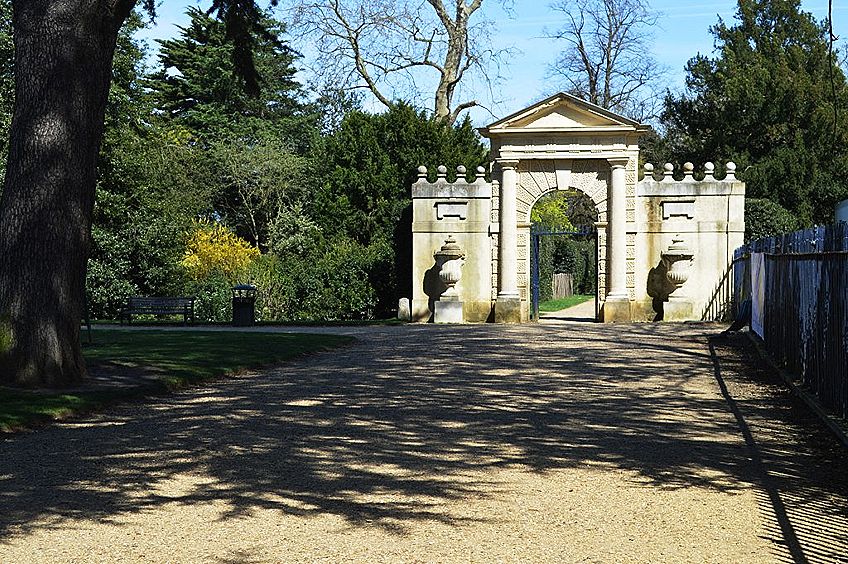 A photograph of Inigo Jones' Portal at Chiswick Firm built in 1621;Matt Brown from London, England, CC Past 2.0, via Wikimedia Commons
A photograph of Inigo Jones' Portal at Chiswick Firm built in 1621;Matt Brown from London, England, CC Past 2.0, via Wikimedia Commons
Mutual characteristics of Neoclassical architecture include the focus on planar surfaces versus the more sculptural surfaces seen in the Bizarre and Rococo styles of compages. It likewise utilized the Classical Orders, which consisted of columns similar the Doric, Ionic, and Corinthian. These orders were prevalent in Greek compages and similarly used in the Neoclassical buildings.
Other features include the emphasis on walls appearing long and, especially, bare in its surface. It is classified as utilizing geometric shapes, clean lines, and "block" shapes. The block shape (rectangular or squared) in Neoclassical architecture is widely visible, it is oft coupled with a flat roof and a dome, with a repetition of columns.
Neoclassical compages also consisted of two phases, or periods, namely, Early, or Palladian, and Loftier Neoclassical architecture.
The Early on catamenia was during the 1700s to 1750s and was significantly influenced past Palladio. The forerunners of this menstruation were architects like Inigo Jones (1573-1652) and Colen Campbell (1676-1729). A well-known example of this style is the Chiswick House (1729) by Richard Boyle (1694-1753). As the 3rd Earl of Burlington and 4th Earl of Cork, he was born into an Anglo-Irish family in Yorkshire. He was pop for introducing the Palladian style of compages in Britain and Republic of ireland, often also referred to equally the "Architect Earl".
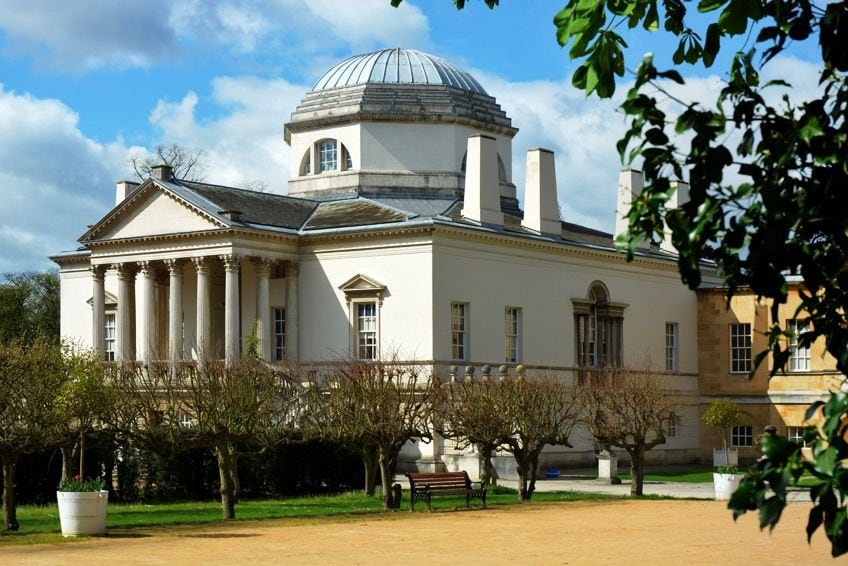 A photograph of Chiswick House designed by architects Richard Boyle and William Kent in 1729;Images George Rex from London, England, CC BY-SA 2.0, via Wikimedia Eatables
A photograph of Chiswick House designed by architects Richard Boyle and William Kent in 1729;Images George Rex from London, England, CC BY-SA 2.0, via Wikimedia Eatables
When we expect at the High Neoclassical architecture, which started during the 1750s, it incorporated more influence from Greek architecture, which was not every bit prevalent in the earlier menstruum. This style is also just known as Neoclassical architecture. Of the endless examples of buildings in this style, common examples include the Hermitage Museum (1787) in Russia.
Another famous building is the Panth é on (1758-1790) in Paris, initially, it was the Church building of St. Geneviève. It was congenital by Jacques-Germain Soufflot (1713-1780). This building, in all its magnificence, located in the 5th arrondissement, is a truthful attestation to the Classical ethics from Greek and Roman architecture, evident in its numerous columns and geometric proportions.
The Always Continued Neoclassical
The Neoclassical mode concluded during the 1850s with the rise of a new movement called Romanticism, which started during the 1780s and lasted until effectually the 1830s. Information technology coincided with Neoclassicism and was about the complete opposite in mode and values. Where Neoclassicism was about rationality and Classical ethics of virtue and social club, Romanticism expressed emotion and the exploration of the senses.
Although this was a complete shift in style, the Neoclassical motion continued and lived on in the Classical ideals that it sought to emulate. We will withal notice the Neoclassical mode in many types of buildings throughout Europe. It was also revived within the Beaux-Arts Architecture, which was a French and American move during the 1830s into the 1940s.
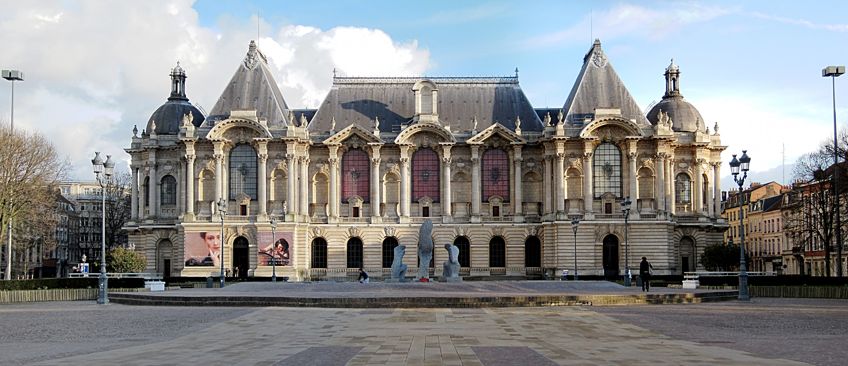 A photograph of Lille Palais des Beaux Arts designed in 1809 past Fernand Delmas and Édouard Bérard;Velvet, CC By-SA 3.0, via Wikimedia Commons
A photograph of Lille Palais des Beaux Arts designed in 1809 past Fernand Delmas and Édouard Bérard;Velvet, CC By-SA 3.0, via Wikimedia Commons
Neoclassicism was a return to the Classics – it sought to revive the ideals of the ancients, namely, society, symmetry, and rationality. It near dutifully depicted what the Classics attained during the Greek and Roman periods and similarly strove to reach in the context of the eighteenth Century and its circuitous and oftentimes tumultuous evolution into the Modern era.
The revival of Classical ideals inside Neoclassical Art was almost a catamenia of reminding the earth once more via visual advice of the beauty and structure so perfected by the ancients (whether they knew information technology or not) – and only we can dream of attaining that in our own Age of Enlightenment.
Have a look at our Neoclassicism webstory here!
Often Asked Questions
What Is Neoclassicism?
Neoclassicism was a revival of Classical ideals from the Greek and Roman periods. It was also a reaction towards the exuberant and oftentimes described "flamboyant" nature of the preceding movements, Baroque and Rococo.
When Was the Neoclassical Period?
The Neoclassical period started in Europe effectually the center of the 1700s (18th Century) and continued during the 1900s (19thursday Century). It initially had roots in Rome but spread to many other countries, primarily France and Great britain, but also Russia and Germany, among others.
What are the Primary Characteristics of Neoclassicism?
As an opposing movement to the Baroque and Rococo, Neoclassicism reverted to Classical virtues of symmetry, proportion, make clean lines, and subdued colors. The subject matter was of mythological and historical scenes with the ideals of heroism and patriotism. It was also inspired by rational thought and calmness of being.
What Influenced the Neoclassical Motility?
It is believed there were three primary influences on the development of Neoclassicism, namely, the seminal and revolutionary texts of historian, Johann Joachim Winckelmann (1717-1768), about defining the periods of Greek and Roman art and architecture. Then in that location were the excavations of Pompeii and Herculaneum, which introduced new artifacts and knowledge virtually Classical Artifact, and lastly, the Grand Tour, which allowed many noble young men and artists to tour Europe (particularly Greece and Rome) and bring dorsum many artifacts and memorabilia, which inspired the development of the revival of Classical culture.
marshallanium1976.blogspot.com
Source: https://artincontext.org/neoclassical-art/
0 Response to "What Is So Modern About the Art of Neoclassicism?"
Post a Comment